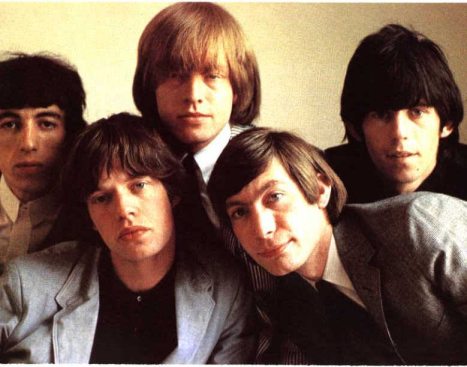The heart of the Rolling Stones was the partnership between
Keith Richards and Mick Jagger---schoolmates who met in a suburb at the edge
of London's eastside united by their love of
American blues and rhythm and blues. During their early years, the group
spent countless hours listening to the recordings of Jimmy Reed, Muddy
Waters, Howlin' Wolf, and Robert Johnson. They took their name from a Muddy
Waters song.The band began to take off in 1963, the
same year they hired Andrew Loog Oldham as their manager. "It's All
Over Now", released in 1964 was their first #1 hit in the UK.

It was Oldham who encouraged Jagger and Richards to start writing their
own material and the first song they penned that began to give the Stones
their own sound was "The Last Time" (1965).Jagger and Richards
also wrote songs that were recorded by other artists. They wrote "As Tears
Go By" recorded by Marianne Faithful, "Take It Or Leave It" recorded by the
Searchers, and "Blue Turns To Grey" recorded by Cliff Richards. The
group cultivated a deliberately different image for itself than most of the
other British groups. The Stones were marketed as lower class rebels and
louts. Their early albums clearly show the influence of rhythm and blues but
they began to create a a sound that was truly their own with "Satisfaction"
(1965) their first #1 hit in the US. Its simple, distorted guitar riff and
lyrics that criticized the establishment culture were resonant with a youth
that was starting to chafe against the status quo. The first Stones album to
consist of entirely original songs was Aftermath, released in 1966.
Ry Cooder introduced Keith Richards to open tunings in the late 1960s and
this influenced the sound on numerous songs such as "Honky Tonk Women,"
"Brown Sugar" and "Start Me Up." Richards had a genius
for creating guitar riffs built on two or three note chords as in the
beginning of "Gimme Shelter."
Over the course of the group's history it has been remarkably stable.
Brian Jones died in 1969 and was replaced by Mick Taylor who was in turn
replaced by Ron Woods in 1975. Bassist Bill Wyman quit the group in 1993.
A signature for the group has always been the snarling, leering presence of
Mick Jagger as a front man. The group has had a reputation for hard living
on the wild side and has been a frequent target of politicians and
media conservatives.
Other #1 hit songs include "Get Off My Cloud" (1965), "Paint It Black" (1966),
"Ruby Tuesday" (1967), "Honky Tonk Women"
(1969), "Brown Sugar" (1971), "Angie" (1973), and "Miss You"
(1978).
Pop artist Andy Warhol once designed an album cover for band (Sticky
Fingers) and drummer Charlie Watts wrote a children's book about jazz
musician Charlie Parker.
